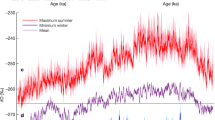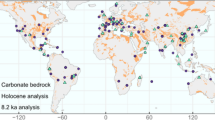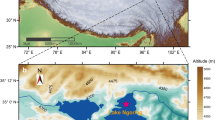Abstract
Relative to the past 2,000 years1,2, the Arctic region has warmed significantly over the past few decades. However, the evolution of Arctic temperatures during the rest of the Holocene is less clear. Proxy reconstructions, suggest a long-term cooling trend throughout the mid- to late Holocene3,4,5, whereas climate model simulations show only minor changes or even warming6,7,8. Here we present a record of the oxygen isotope composition of permafrost ice wedges from the Lena River Delta in the Siberian Arctic. The isotope values, which reflect winter season temperatures, became progressively more enriched over the past 7,000 years, reaching unprecedented levels in the past five decades. This warming trend during the mid- to late Holocene is in opposition to the cooling seen in other proxy records3,5,9. However, most of these existing proxy records are biased towards summer temperatures. We argue that the opposing trends are related to the seasonally different orbital forcing over this interval. Furthermore, our reconstructed trend as well as the recent maximum are consistent with the greenhouse gas forcing and climate model simulations, thus reconciling differing estimates of Arctic and northern high-latitude temperature evolution during the Holocene.
This is a preview of subscription content, access via your institution
Access options
Subscribe to this journal
Receive 12 print issues and online access
$259.00 per year
only $21.58 per issue
Buy this article
- Purchase on Springer Link
- Instant access to full article PDF
Prices may be subject to local taxes which are calculated during checkout



Similar content being viewed by others
References
Kaufman, D. S. et al. Recent warming reverses long-term Arctic cooling. Science 325, 1236–1239 (2009).
PAGES 2k Consortium, Continental-scale temperature variability during the past two millennia. Nature Geosci. 6, 339–346 (2013).
Marcott, S. A., Shakun, J. D., Clark, P. U. & Mix, A. C. A reconstruction of regional and global temperature for the past 11,300 years. Science 339, 1198–1201 (2013).
Vinther, B. M. et al. Holocene thinning of the Greenland ice sheet. Nature 461, 385–388 (2009).
Wanner, H. et al. Mid- to Late Holocene climate change: An overview. Quat. Sci. Rev. 27, 1791–1828 (2008).
Timm, O. & Timmermann, A. Simulation of the last 21,000 years using accelerated transient boundary conditions. J. Clim. 20, 4377–4401 (2007).
Lohmann, G., Pfeiffer, M., Laepple, T., Leduc, G. & Kim, J. H. A model-data comparison of the Holocene global sea surface temperature evolution. Clim. Past 9, 1807–1839 (2013).
Braconnot, P. et al. Results of PMIP2 coupled simulations of the Mid-Holocene and Last Glacial Maximum—Part 1: Experiments and large-scale features. Clim. Past 3, 261–277 (2007).
Sundqvist, H. S. et al. Arctic Holocene proxy climate database—new approaches to assessing geochronological accuracy and encoding climate variables. Clim. Past 10, 1605–1631 (2014).
Serreze, M. C. & Barry, R. G. Processes and impacts of Arctic amplification: A research synthesis. Glob. Planet. Change 77, 85–96 (2011).
Snow, Water, Ice and Permafrost in the Arctic (SWIPA): Climate Change and the Cryosphere (Arctic Monitoring and Assessment Programme, 2011); http://www.amap.no/documents/doc/snow-water-ice-and-permafrost-in-the-arctic-swipa-climate-change-and-the-cryosphere/743
Miller, G. H. et al. Temperature and precipitation history of the Arctic. Quat. Sci. Rev. 29, 1679–1715 (2010).
Sundqvist, H. S. et al. Climate change between the mid and late Holocene in northern high latitudes—Part 1: Survey of temperature and precipitation proxy data. Clim. Past 6, 591–608 (2010).
Birks, H. B., Heiri, O., Seppä, H. & Bjune, A. E. Strengths and weaknesses of quantitative climate reconstructions based on late-Quaternary biological proxies. Open Ecol. J. 3, 68–110 (2010).
Andreev, A. A., Klimanov, V. A. & Sulerzhitsky, L. D. Vegetation and climate history of the Yana River lowland, Russia, during the last 6400 yr. Quat. Sci. Rev. 20, 259–266 (2001).
Walter, K. M., Zimov, S. A., Chanton, J. P., Verbyla, D. & Chapin, F. S. III Methane bubbling from Siberian thaw lakes as a positive feedback to climate warming. Nature 443, 71–75 (2006).
Lachenbruch, A. H. Mechanics of Thermal Contraction Cracks and Ice-Wedge Polygons in Permafrost (Geological Society of America Special Paper 70, 1962)
Mackay, J. R. Oxygen isotope variations in permafrost, Tuktoyaktuk Peninsula area, Northwest Territories. Current Res. B 83-1B, 67–74 (1983).
Meyer, H. et al. Permafrost evidence for severe winter cooling during the Younger Dryas in northern Alaska. Geophys. Res. Lett. 37, L03501 (2010).
Schwamborn, G., Rachold, V. & Grigoriev, M. N. Late Quaternary sedimentation history of the Lena Delta. Quat. Intern. 89, 119–134 (2002).
Dahl-Jensen, D. et al. Past temperatures directly from the Greenland ice sheet. Science 282, 268–271 (1998).
Braconnot, P. et al. Evaluation of climate models using palaeoclimatic data. Nature Clim. Change 2, 417–424 (2012).
Mairesse, A., Goosse, H., Mathiot, P., Wanner, H. & Dubinkina, S. Investigating the consistency between proxy-based reconstructions and climate models using data assimilation: A mid-Holocene case study. Clim. Past 9, 2741–2757 (2013).
Laskar, J. et al. A long-term numerical solution for the insolation quantities of the Earth. Astron. Astrophys. 428, 261–285 (2004).
Zhang, Q. et al. Climate change between the mid and late Holocene in northern high latitudes; Part 2: Model-data comparisons. Clim. Past 6, 609–626 (2010).
Joos, F. & Spahni, R. Rates of change in natural and anthropogenic radiative forcing over the past 20,000 years. Proc. Natl Acad. Sci. USA 105, 1425–1430 (2008).
Bauch, H. A. et al. Chronology of the Holocene transgression at the North Siberian margin. Glob. Planet. Change 31, 125–139 (2001).
Opel, T., Dereviagin, A. Y., Meyer, H., Schirrmeister, L. & Wetterich, S. Palaeoclimatic information from stable water isotopes of Holocene ice wedges on the Dmitrii Laptev Strait, northeast Siberia, Russia. Permafrost Periglacial Process. 22, 84–100 (2011).
Brohan, P., Kennedy, J. J., Harris, I., Tett, S. F. B. & Jones, P. D. Uncertainty estimates in regional and global observed temperature changes: A new data set from 1850. J. Geophys. Res. 111, D12106 (2006).
Laepple, T. & Lohmann, G. Seasonal cycle as template for climate variability on astronomical time scales. Paleoceanography 24, PA4201 (2009).
Acknowledgements
We greatly acknowledge numerous people involved in field and lab work, in particular L. Schoenicke and C. Springer (AWI Potsdam) for stable isotope analyses. We acknowledge the World Climate Research Programme’s Working Group on Coupled Modelling, which is responsible for CMIP, and we thank the climate modelling groups for producing and making available their model output. For CMIP the US Department of Energy’s Programme for Climate Model Diagnosis and Intercomparison provided coordinating support and led development of software infrastructure in partnership with the Global Organisation for Earth System Science Portals. The PMIP3 Data archives are supported by CEA and CNRS. This paper is a contribution to the research programme PACES II, Topic 3 of the Alfred Wegener Institute, Helmholtz Centre for Polar and Marine Research and to the Eurasian Arctic Ice 4k project (grant OP 217/2-1 by Deutsche Forschungsgemeinschaft awarded to T.O.). T.L. was supported by the Initiative and Networking Fund of the Helmholtz Association (grant VG-900NH).
Author information
Authors and Affiliations
Contributions
H.M., A.Y.D. and T.O. designed the study and carried out the fieldwork. H.M. and K.H. performed the stable water isotope analyses on ice wedges. H.M. wrote the first draft of the manuscript. T.L. performed the statistical analysis of the isotope and climate model data. All authors contributed to data interpretation and the preparation of the final manuscript.
Corresponding author
Ethics declarations
Competing interests
The authors declare no competing financial interests.
Supplementary information
Supplementary Information
Supplementary Information (PDF 2598 kb)
Rights and permissions
About this article
Cite this article
Meyer, H., Opel, T., Laepple, T. et al. Long-term winter warming trend in the Siberian Arctic during the mid- to late Holocene. Nature Geosci 8, 122–125 (2015). https://doi.org/10.1038/ngeo2349
Received:
Accepted:
Published:
Issue Date:
DOI: https://doi.org/10.1038/ngeo2349
This article is cited by
-
Revisiting the Holocene global temperature conundrum
Nature (2023)
-
Holocene thermal maximum mode versus the continuous warming mode: Problems of data-model comparisons and future research prospects
Science China Earth Sciences (2023)
-
Holocene temperature variation recorded by branched glycerol dialkyl glycerol tetraethers in a loess-paleosol sequence from the north-eastern Tibetan Plateau
Frontiers of Earth Science (2023)
-
Current Siberian heating is unprecedented during the past seven millennia
Nature Communications (2022)
-
The Holocene temperature conundrum answered by mollusk records from East Asia
Nature Communications (2022)



